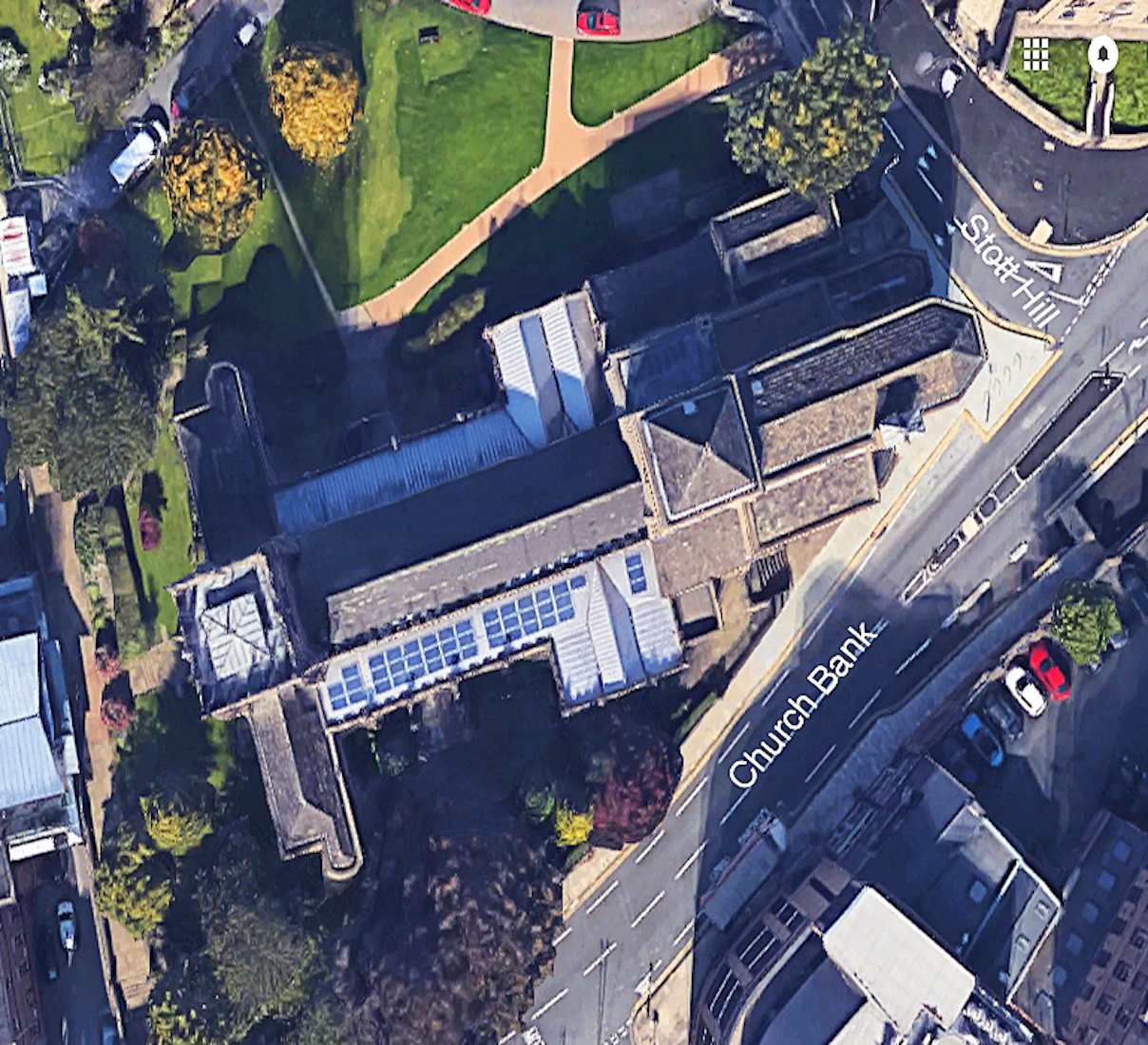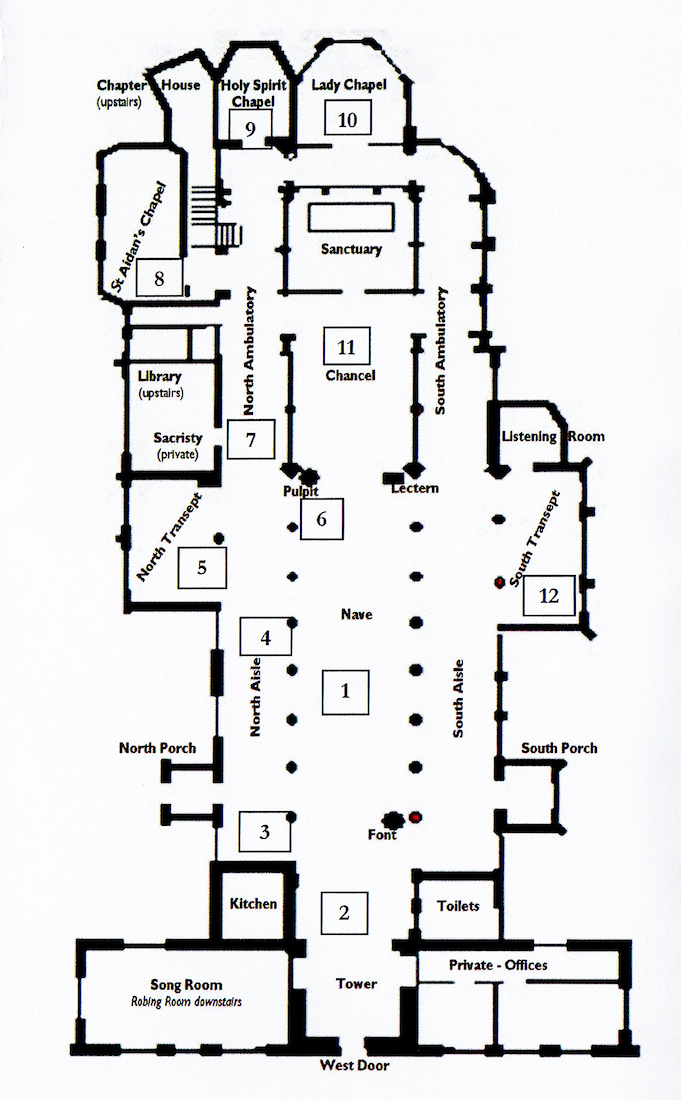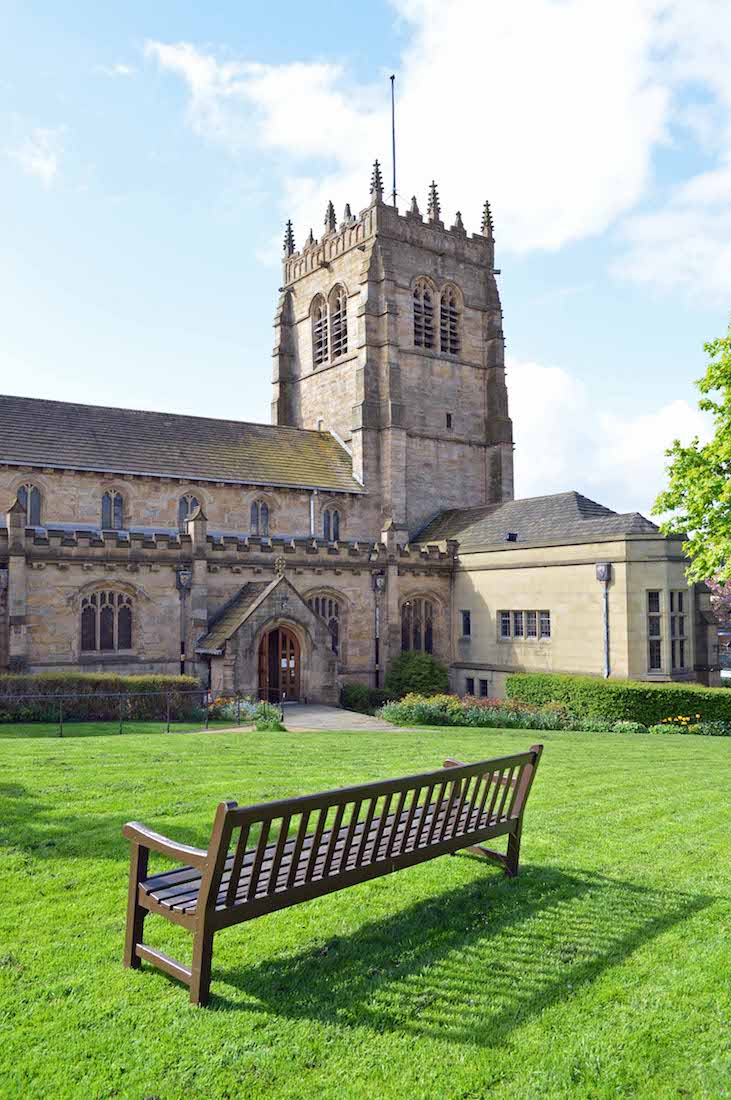WELCOME TO
BRADFORD CATHEDRAL
WEST YORKSHIRE ENGLAND
PAUL SCOTT

SATELLITE VIEW
Bradford Cathedral stands on land which rises up steeply from Church Bank (Road), but which has a very pleasant garden area on the other side. The axis of the Cathedral is just a few degrees skew of geographical east-west with the sanctuary close to east in orientation. We can therefore identify our liturgical directions (for example ‘East’ with a capital) with the geographical directions (for example ‘east’).
We notice the tower at the West end with an added transept. The nave belonged to the old Church, and to this was added new transepts and the whole East end. The relatively new solar panels are obvious from this view.
Bradford City centre lies to the West of the Cathedral, and within easy walking distance.

This is the official Cathedral plan. The numbers indicate special points of interest in the Cathedral guide. We shall assign our own numbers!
After circumnavigating the outside of the Cathedral, we shall enter through the North porch, and in turn, investigate the nave and transepts, the chancel, the ambulatory and chapels, the Listening Room (with permission!) and finally the sanctuary.
The Cathedral has the appearance of having ‘grown like Topsy’, and this is probably true, but for the visitor the different spaces blend together well. So, for example, a number of the old Victorian windows can be found in the new Eastern addition.
An historical account from Wikipedia follows; some brief historical notes are also included in the main text.
If you wish to begin the Cathedral tour immediately, click / tap on START.
You can access intermediate points in the tour by a tap / click on the following links:
NOTE ON MAGNIFYING IMAGES
With this website format the images are large enough for most purposes. If there is a need for greater magnification of an image, go to the identical photo on
https://www.flickr.com/photos/paulscottinfo/albums
and use Command - + (Mac) or Windows - + (Windows).
HISTORY
[Wilipedia]
Bradford Cathedral (Cathedral Church of St Peter) is a cathedral in Bradford, West Yorkshire, England, which is built on a site used for Christian worship since the 8th century, when missionaries based in Dewsbury evangelised the area. Until 1919, it was the parish church of St Peter.
The first church on the site was built in Anglo-Saxon times and fell into ruin during the Norman Invasion in 1066. The Norman Lady of the Manor, Alice de Laci, built a second church that would be destroyed by raiding Scots three hundred years later. During the 14th century the church was rebuilt and some of the older masonry may have been used in the reconstruction of the nave. The nave arcades, the oldest parts of the present building, were completed in 1458. A clerestory above them was added by the end of the 15th century. Chantry chapels were founded, on the North side of the chancel by the Leventhorpe family, and on the South by the owners of Bolling Hall. The tower in the Perpendicular style was added to the West end and finished in 1508. In 1854 Robert Mawer carved a new reredos in Caen stone for the church. There is a photograph of it in the church archive. This reredos was lost during the 1950s rebuild by Edward Maufe.
Originally in the Diocese of York, the church was in the Diocese of Ripon before becoming a cathedral in 1919, when the Diocese of Bradford was created; it became one of three co-equal cathedrals of the new Diocese of Leeds upon its creation on 20 April 2014.
The building was extended in the 1950s and 1960s by Edward Maufe. The East end of the Cathedral is Maufe’s work, but he reused the Morris & Co. stained glass from the old East window – there is therefore Victorian stained glass throughout the building including at the West end a window showing the women of the Bible. The many wall monuments include a sculpture by John Flaxman. Maufe also extended the West of the Cathedral on either side of the tower.
In 1987 the nave and West end were re-ordered so as to provide the setting and amenities needed for the increasing number of visitors and the many varied occasions when large numbers of people come to the Cathedral. New entrances were made through the tower walls to the offices and Song Room. The roof panelling was cleaned and restored and new lighting was installed. To enable flexibility of use the Victorian pews were replaced by chairs. The nave organ was removed to give more light and space at the west end, and a Bradford Computer Organ was installed, complementing the pipe organ in the choir with loudspeakers in the nave.
The hassocks were embroidered by people from many parishes in the Diocese. They depict Christian symbols and also a woolsack and the White Rose of York. The finest embroidery is seen on the cushions in the Sanctuary and the Choir.
At the beginning of the 21st century, the Cathedral authorities decided to develop a museum of religion in St Peter’s House (built in the 19th century as Bradford’s main Post Office). The visitor numbers were much lower than expected and the project collapsed leaving the Cathedral in debt, from which it was discharged in 2007. St Peter’s House is now owned by a South Asian arts group, Kala Sangam.
The Cathedral is set in a small conservation area which includes the close to its north. The close provides modern housing for the Dean and Canons Residentiary, the Bishop’s official residence, Bishopcroft, being in Heaton, approximately 3 miles (4.8 km) from the city centre.
The Cathedral and its predecessors were built on the shelf of alluvial land that had formed on the outside of the bend where Bradford Beck turns north, but the town grew up on the lower ground on the other side of the beck, so the Church was always just outside the centre of town. In the 19th and 20th centuries the Cathedral was partly hidden from the centre by buildings, first by the Post Office just below it, and subsequently by the 1960s developments of Forster Square and Petergate. The latter areas were demolished in 2006, leaving the Cathedral more visible than for many years prior to the completion of the Broadway Centre in 2015.
https://en.wikipedia.org/wiki/Bradford_Cathedral



